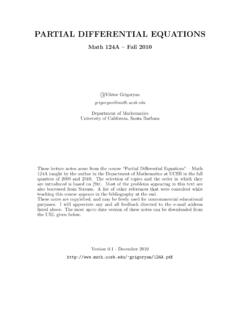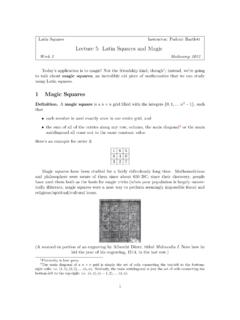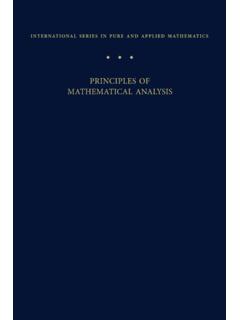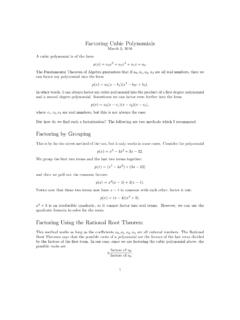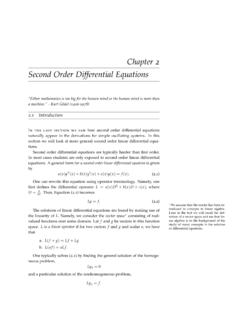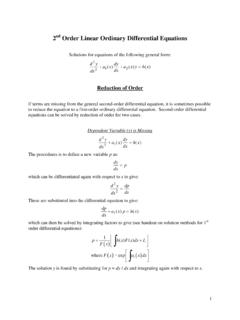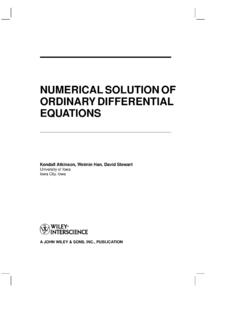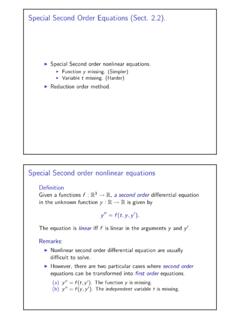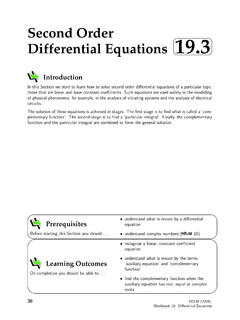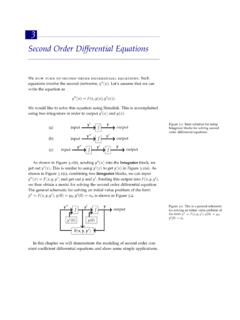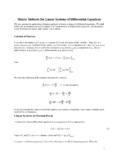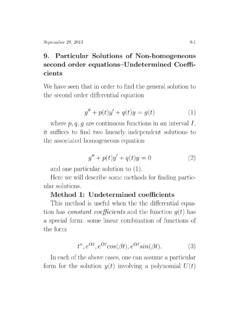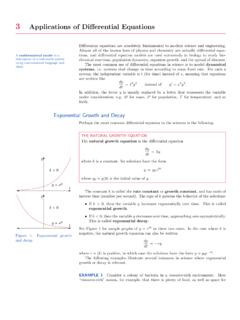Transcription of PARTIAL DIFFERENTIAL EQUATIONS - UC Santa Barbara
1 PARTIAL DIFFERENTIAL EQUATIONSMath 124A Fall 2010 Viktor of MathematicsUniversity of California, Santa BarbaraThese lecture notes arose from the course PARTIAL DIFFERENTIAL EQUATIONS Math124A taught by the author in the Department of Mathematics at UCSB in the fallquarters of 2009 and 2010. The selection of topics and the order in which theyare introduced is based on [Str]. Most of the problems appearing in this text arealso borrowed from Strauss. A list of other references that were consulted whileteaching this course appears in the bibliography at the notes are copylefted, and may be freely used for noncommercial educationalpurposes.
2 I will appreciate any and all feedback directed to the e-mail addresslisted above. The most up-to date version of these notes can be downloaded fromthe URL given - December 2010 ~ Classification of PDEs .. Examples .. Conclusion ..3 Problem Set 142 First- order linear The method of characteristics .. General constant coefficient EQUATIONS .. Variable coefficient EQUATIONS .. Conclusion .. 103 Method of characteristics Transport equation .. Quasilinear EQUATIONS .. Rarefaction .. Shock waves .. Conclusion .. 14 Problem Set 2154 Vibrations and heat Vibrating string.
3 Vibrating drumhead .. Heat flow .. Stationary waves and heat distribution .. Boundary conditions .. Examples of physical boundary conditions .. Conclusion .. 205 Classification of second order linear Hyperbolic EQUATIONS .. Parabolic EQUATIONS .. Elliptic EQUATIONS .. Conclusion .. 25 Problem Set 3266 Wave equation: Initial value problem .. The Box wave .. Causality .. Conclusion .. 337 The energy Energy for the wave equation .. Energy for the heat equation .. Conclusion .. 37 Problem Set 438i8 Heat equation: The maximum principle.
4 Uniqueness .. Stability .. Conclusion .. 429 Heat equation: Invariance properties of the heat equation .. Solving a particular IVP .. Solving the general IVP .. Conclusion .. 46 Problem Set 54710 Heat equation: interpretation of the Dirac delta function .. Interpretation of the solution .. Conclusion .. 5211 Comparison of wave and heat Comparison of wave to heat .. Conclusion .. 56 Problem Set 65712 Heat conduction on the Neumann boundary condition .. Conclusion .. 6113 Waves on the Neumann boundary condition .. Conclusion .. 6514 Waves on the finite The parallelogram rule.
5 Conclusion .. 69 Problem Set 77015 Heat with a Source on the half-line .. Conclusion .. 7416 Waves with a Source on the half-line .. Conclusion .. 7817 Waves with a source: the operator The operator method .. Conclusion .. 82 Problem Set 883ii18 Separation of variables: Dirichlet Wave equation .. Heat equation .. Eigenvalues .. Conclusion .. 8719 Separation of variables: Neumann Wave equation .. Heat equation .. Mixed boundary conditions .. Conclusion .. 90 Problem Set 991 Bibliography92iii1 IntroductionRecall that an ordinary DIFFERENTIAL equation (ODE) contains an independent variablexand a dependentvariableu, which is the unknown in the equation.
6 The defining property of an ODE is that derivativesof the unknown functionu =dudxenter the equation. Thus, an equation that relates the independentvariablex, the dependent variableuand derivatives ofuis called anordinary DIFFERENTIAL equation. Someexamples of ODEs are:u (x) =uu + 2xu=exu +x(u )2+ sinu= lnxIn general, and ODE can be written asF(x,u,u ,u ,..) = contrast to ODEs, a PARTIAL DIFFERENTIAL equation (PDE) contains PARTIAL derivatives of the depen-dent variable, which is an unknown function in more than one variablex,y,.. Denoting the partialderivative of u x=ux, and u y=uy, we can write the general first order PDE foru(x,y) asF(x,y,u(x,y),ux(x,y),uy(x,y)) =F(x,y,u,ux,uy) = 0.
7 ( )Although one can study PDEs with as many independent variables as one wishes, we will be primar-ily concerned with PDEs in two independent variables. Asolutionto the PDE ( ) is a functionu(x,y) which satisfies ( ) for all values of the variablesxandy. Some examples of PDEs (of physicalsignificance) are:ux+uy= 0transport equation( )ut+uux= 0inviscid Burger s equation( )uxx+uyy= 0 Laplace s equation( )utt uxx= 0wave equation( )ut uxx= 0heat equation( )ut+uux+uxxx= 0 KdV equation( )iut uxx= 0 Shr odinger s equation( )It is generally nontrivial to find the solution of a PDE, but once the solution is found, it is easy toverify whether the function is indeed a solution.
8 For example to see thatu(t,x) =et xsolves the waveequation ( ), simply substitute this function into the equation:(et x)tt (et x)xx=et x et x= Classification of PDEsThere are a number of properties by which PDEs can be separated into families of similar two main properties order of a PARTIAL DIFFERENTIAL equation is the order of the highest derivative entering theequation. In examples above ( ), ( ) are of first order ; ( ), ( ), ( ) and ( ) are of secondorder; ( ) is of third means that all instances of the unknown and its derivatives enter the equationlinearly. To define this property, rewrite the equation asLu= 0,( )whereLis an operator, which assignsua new functionLu.
9 For exampleL= 2 x2+ 1, thenLu=uxx+ operatorLis called linear ifL(u+v) =Lu+Lv,andL(cu) =cLu( )1for any functionsu,vand constantc. The equation ( ) is called linear, ifLis a linear operator. Inour examples above ( ), ( ), ( ), ( ), ( ) are linear, while ( ) and ( ) are nonlinear ( ). To see this, let us check, ( ) for linearity:L(u+v) = (u+v)t (u+v)xx=ut+vt uxx vxx= (ut uxx) + (vt vxx) =Lu+Lv,andL(cu) = (cu)t (cu)xx=cut cuxx=c(ut uxx) = , indeed, ( ) is a linear equation, since it is given by a linear operator. To understand how linearitycan fail, let us see what goes wrong for equation ( ):L(u+v) = (u+v)t+(u+v)(u+v)x=ut+vt+(u+v)(ux+vx) = (ut+uux)+(vt+vvx)+uvx+vux6=Lu+ can check that the second condition of linearity fails as well.
10 This happens precisely due to thenonlinearity of theuuxterm, which is quadratic in uand its derivatives .Notice that for a linear equation, ifuis a solution, then so iscu, and ifvis another solution, thenu+vis also a solution. In general any linear combination of solutionsc1u1(x,y) +c2u2(x,y) + +cnun(x,y) =n i=1ciui(x,y)will also solve the linear equation ( ) is calledhomogeneouslinear PDE, while the equationLu=g(x,y)( )is calledinhomogeneouslinear equation. Notice that ifuhis a solution to the homogeneous equation( ), andupis a particular solution to the inhomogeneous equation ( ), thenuh+upis also a solutionto the inhomogeneous equation ( ).
